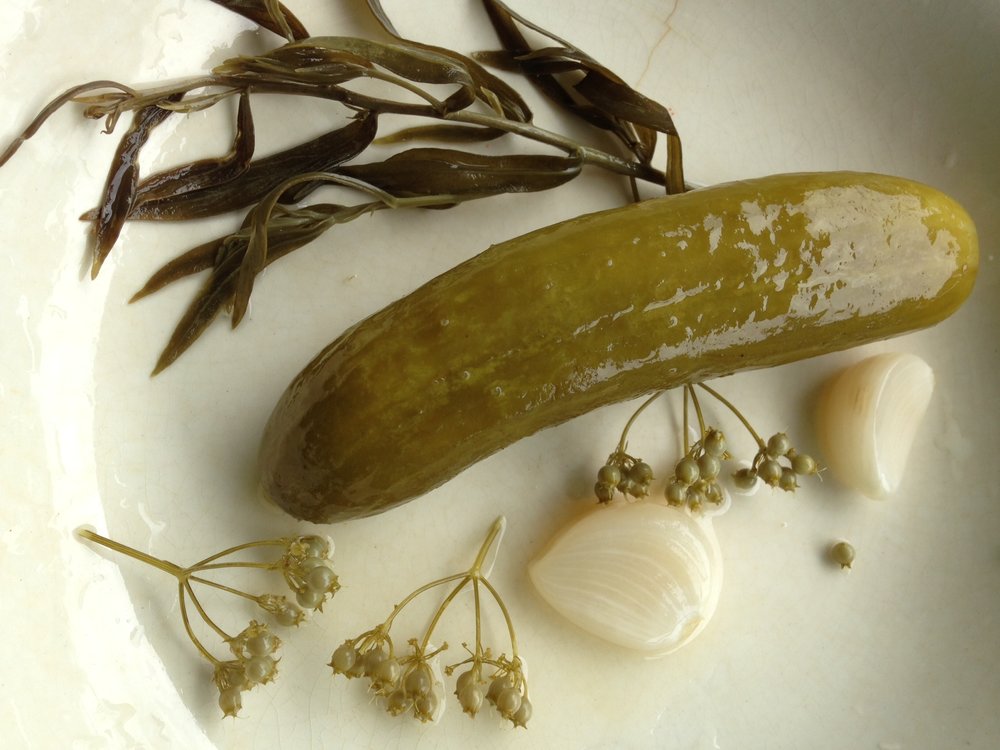Fat Of The Land - All In A Pickle
 Pickles have personality that seems larger than the sum of their parts—puckering acidity, chopped vegetables, salt and a pinch or two of seasoning add up to refreshing brightness and enigmatic flavors that effortlessly invigorate a bowl of rice, a sandwich, or a steak.
Pickles have personality that seems larger than the sum of their parts—puckering acidity, chopped vegetables, salt and a pinch or two of seasoning add up to refreshing brightness and enigmatic flavors that effortlessly invigorate a bowl of rice, a sandwich, or a steak.
There are essentially two kinds of pickles: fermented and not fermented. Fermented pickles use a salt brine to isolate lacto-bacteria and create an acidic environment that preserves the food suspended in it. Fermented pickles are a compelling combination of salty and sour flavors, and include among their ranks the now ubiquitous deli staples of sauerkraut and kosher dills.
Pickles made without fermentation rely on another form of acid to hinder spoilage, usually vinegar. Vinegar pickles may be sealed and stashed in the pantry using the water-bath canning method or stored unsealed in the refrigerator. They are acidic, salty and often sweet, as sugar is a common addition to balance out the vinegar’s sharpness.
The difference between the two categories is vast. Fermentation transforms a vegetable into something new, creating biological and flavor components that were not present in its raw form. Vinegar brines build, maintaining the spirit of the fresh vegetable’s flavor and adding layers of brightness, herbal notes, and sweet or aromatic spices.
Fermented cucumbers were my first pickle love, and I adored the subtle funkiness of their flavor so much I often wrote off their vinegar-brined kin as being too ostentatious. The grocers and restaurants of my formative years offered little diversity in pickles; then came a pickle renaissance, and in sauntered so much more than overly sweet relishes and bread-and-butter medallions.
As interest in home canning has increased in the last decade, vinegar pickle recipes have proliferated, stretching far beyond the traditional beet, dilly bean, and cucumber standbys. Driven by DIY ethos, some restaurants now compose their own pickled preparations, lining their pantries and countertops with handsome, exotically colored jars. Pickled novelties garnish plates, perch on cocktail rims, and add an instant dash of culinary mystery to otherwise familiar dishes.
Vinegar pickles have one serious advantage over fermented pickles for chefs and home cooks alike: they can go from preparation to plate in as little as a few minutes. Known as quick pickles, vegetables doused with vinegar, salt and any number of flavorings may be used immediately for the highest contrast of flavor and texture, or after marinating for a few hours or days to mellow and blend.
While pickles became mainstays of nearly every culinary tradition because they are so good at preserving foods rich in vitamins and minerals, we also acquired a taste for them along the way. We’ve since developed a wide range of food preservation techniques and greatly increased our access to year-round fresh vegetables, and yet pickles still satisfy and inspire us.
Now a traditional food, a frill du cuisine, a blank canvas for gastronomic whim or nostalgic indulgence, pickles are always refreshing—cutting through rich flavors, showcasing seasonal produce, making us at once thirsty with their salt and quenched by their acidity. But perhaps, more than anything, we love pickles because they allow us to conspire with time and its magic.
"On a hot day in Virginia, I know nothing more comforting than a fine spiced pickle, brought up trout-like from the sparkling depths of the aromatic jar below the stairs of Aunt Sally's cellar." - Thomas Jefferson
Want to learn more about pickles? Chef Kathryn will be sharing pickling ideas this Sunday starting at 11am.
Sarah West is a gardener, eater and admirer of the agricultural arts. She gladly spends her Sundays as assistant manager of the Hillsdale Farmers’ Market, basking in the richness of its producers’ bounty and its community’s energy. Find archives and more at http://thefatofthelandblog.wordpress.com.